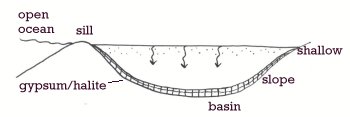
3. Depositional models
Barred-basin: deep to shallow
 |
Diagram adapted from Tucker, (1991). |
The deep-water deep-basin model assumes the existence of a deep basin separated from the open ocean by some kind of topographic sill.
The sill acts as a barrier to prevent free interchange of water in the basin with water in the open ocean, but it allows enough water into the basin to replenish that lost by evaporation.
Seaward escape of some brine allows a particular concentration of brine to be maintained for a long time leading to thick deposits of certain evaporite minerals such as gypsum.
The deposits are laminated turbidite graded beds of anhydrite and slumped horizons of contorted and brecciated evaporites (Tucker, 1991).
The vertical rock sequence would start with sapropelic deposits representing an initial stagnation of the water, as the barrier became effective, followed by laminated anhydrite as evaporation proceeded.
When evaporation is well advanced, halite would next be deposited until the basin was nearly filled. Final evaporation of brines in Salinas and sabkhas might then produce potassium and magnesium salts.
Barred-basin: desiccated
 |
Diagram adapted from Tucker(1991). |
The shallow water deep, basin model requires that the brine level be reduced below the level of the sill, with recharge of water from the open ocean taking place only by seepage through the sill or by periodic overflow of the sill.
Total desiccation of the floors of such basins, could occur periodically allowing the evaporative process to go to completion depositing a complete evaporite sequence, including magnesium and potassium salts.
Thick evaporite deposit could accumulate under these conditions owing continued subsidence (Tucker, 1991).
 |
Diagram adapted from, Tucker (1991). |
Deep water evaporite facies are laminated with individual laminae which can be correlated over distances of many kilometers.
It is this feature which helps distinguish deep-water evaporites from other evaporite type deposits.